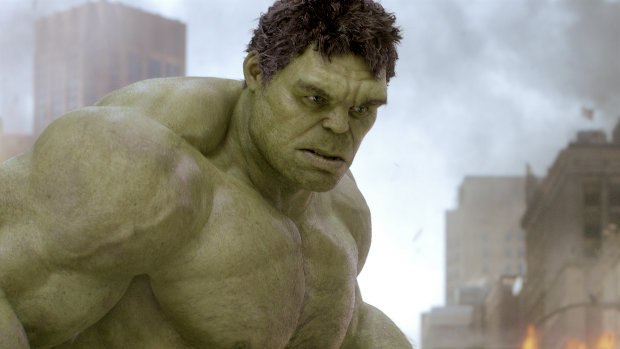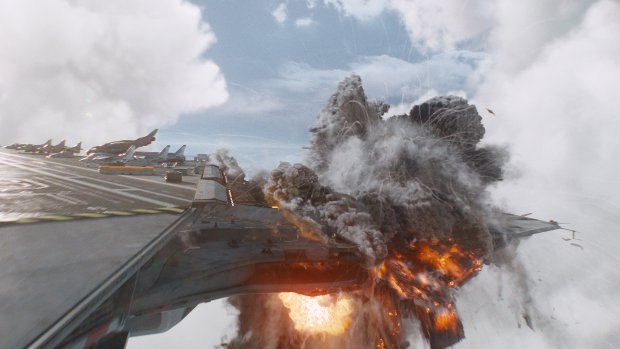The film’s Executive Producer and ILM VFX Supervisor discuss the Oscar®-nominated superhero epic’s visual effects challenges.
Watch AWN’s exclusive video interview with Jeff White from FMX.
Watch AWN’s exclusive video interviews with Victoria Alonso from SIGGRAPH and FMX.
Currently the third highest grossing film internationally of all time, The Avengers has become the crown-jewel of Marvel’s superhero movie franchise. Arguably one of the most complicated visual effects driven films of all time, the task of managing the integration of such sophisticated work across a dozen studios fell to executive producer Victoria Alonso. I recently had a chance to speak with her, along with ILM visual effects supervisor Jeff White, who, among other aspects of the film, was intimately involved in the creation of The Hulk and the helicarrier.
Dan Sarto: The Avengers was truly a behemoth of a film to create. Integrating visual effects from a number of different studios, a huge number of digital characters, the list goes on and on. Looking back on the production, what are your feelings on having pulled it off so successfully?
Victoria Alonso: It was scary and exhilarating. Every day, you think, “Oh my god, are we going to make it?” That constant battle against time. We always say we are trying for the utmost quality. We’re striving for the utmost consistency. You can’t have one sequence that looks awesome and then everything else be anything less. For us at Marvel, the commitment is to make a consistent, great looking movie that has a story people want to stay on their seats for two hours and watch. Even when you see the movie and you think we have something that the fans will like, you don’t know until the fans show up. It’s always a leap of faith even after you’ve been working on it for seven years. You say, “OK, let’s cross our fingers…” and pray they love it as much as we love it because we surely left a lot on the line for it. I’ve only cried twice in my career. When we crossed the billion dollar mark [on this film] I cried. Tears of joy. You don’t have those moments in your career as a producer when people say, “Your movie just crossed the billion dollar mark!” It meant not only that people went to see it but their reaction was very positive.
DS: Along those lines, as you’re making the movie, there must be particular sequences you figure will resonate with the audience more than others. But of course, you never know until the film is released. Are there any scenes or sequences where you were surprised at the audience’s reactions?
VA: I was surprised that the whole Alien story line was accepted with such open arms and so wholeheartedly. People were into it. In concept, I thought it was going to take me out of the picture. But god bless ILM and the other 11 companies that ushered us through the process. They created something that was phenomenally interesting and integrated in a way that felt it belonged there. I could buy it. It was a journey I knew I was taking and it didn’t take me out of the film. I was happily surprised. You always have faith that “Well, let’s see what happens.” But, you do have that tummy ache for months and months.
Jeff White: Any time you’re creating a new race, you have to get a lot of buy in at the low level from the audience. With the Chitauri, early versions were very gold, very bright. It just wasn’t working. We went back to the drawing board and really weathered them down and created more character in them, which I think really helped them fit in the world better.
DS: I think it’s safe to say that with the release of this film, the general consensus is that you finally got the Hulk right. I think an integral part of the film’s success was choosing Mark Ruffalo for the Hulk, coupled with how you created and animated his character. What was different this time? What made the Hulk work so well?
JW: I could talk for a half hour on all the great decisions that were made along the way with the Hulk. First, casting Mark Ruffalo. We owe him so much credit in this process. There’s no great Hulk without a great Bruce Banner. He played that perfectly. He was really open and involved in the visual effects process. He wanted to contribute everything he possible could. That was key for us. He was incorporated into the design, which was a departure from previous Hulks. That gave us something to build around. We said, for this Hulk, first, we’re going to start by replicating Mark Ruffalo digitally. Once we solve the big problems there, then we can re-sculpt that to become the Hulk. He did several motion-capture performances. We had to develop a lot of new re-targeting technologies so that we could utilize those performances and still have them correctly represented with how different the facial structure and proportions are. That was a big part of it. The other part of it was Joss [Whedon] just giving us great moment to animate. To be able to do a shot where Hulk jumps from building to building, smashing aliens, flying through the air, that’s all really fun stuff to do.
DS: Jeff, when we spoke before at FMX, you spoke specifically about the lighting challenges faced creating the Hulk. For example, you mentioned that initially, when rendering the face, the large brows on the forehead made it difficult to see the eyes. Can you tell us a bit about some of the specific lighting challenges you faced getting the Hulk to look so good?
VA: What makes you think creating a green guy will have any lighting challenges?
JW: He was so reactive to the environment we joked around about how many different terminologies we had for different Hulk shades. We could probably start a Pantone color book. It was really interesting for us. Our lighting environment was built around a combination of the lighting that Seamus McGarvey, our DP, had on location in New Mexico as well as the New York City photography to provide the buildings and ground reflections. When we started lighting him in the shots, our first approach was to add many rims and kick lights. We were all trying to find the sculptural detail in the face. What we found was that it made him look very illustrated. So we worked on looking at the plate, looking at what the rest of the characters had so we could really help him look integrated. We had to flatten out some of the lighting, then go back in with separate passes to add little highlights to the cheekbones or the chin to carve out those details.
Victoria and I would talk quite a bit. His hair might look good in a close-up but sometimes it looked like doll hair. Sometimes it went very Monchhichi like that toy from the 80s. Almost every shot was a custom hairdo.
DS: With multiple films under production at one time, how much of your visual effects production pipeline has to be reinvented with each new film? Can you take advantage of what you’ve already built or is each film so distinct that you need to create something unique just for that film?
VA: Well, for example, on Iron Man, we’ve used three new suits. We have his older suits in the Hall of Armor, which I’m sure you’ve seen in the trailer for Iron Man 3. But, the reuse of the model property is very limited. What is important are all the lessons we’ve learned on how to rig it, what not to do and where the model breaks Whether the suit is red, white and blue, all white, all brushed metal, or all red, the behavior of the suit, a thousand pound suit, is very similar from suit to suit. All the little cheats we’ve learned over the years on how to animate it, how the shoulders collapse, how the knees have issues, how the hips do this the chest gets bulky and then it gets leaner, we’ve developed a shorthand [for dealing with that]. We can say, “Hey, remember that shot in Iron Man 1 where blah blah blah…Remember what we did with that? OK, right, I get that…” and boom, we go with it. The way I look at it I always say that with these films and our vendors, it’s a long term relationship. Hopefully, one thing that we’ve done is even if you don’t have the asset per se that you’ll reuse, the learning experience is where you can get most of the savings.
JW: I would agree. We set out at the beginning of the show to make the assets as shareable as possible. The Avengers was the best example of collaboration between vendors. We built a helicarrier, we sent it to Weta, they destroyed Engine 3, they sent that back to us, we sent that down to Scanline. With the size of the shows these days, it’s impossible to avoid sharing and cross-collaboration between vendors. Once the show gets going, we’re all in it together. It was really great working with all those guys. Everyone at Marvel was really involved in making sure the looks were consistent between the different vendors.
--
Dan Sarto is editor-in-chief and publisher of Animation World Network.
Dan Sarto is Publisher and Editor-in-Chief of Animation World Network.











